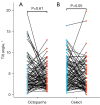Efficacy and safety of a novel vena cava filter on pulmonary embolism prophylaxis: a prospective, multicenter, randomized, parallel, positive-controlled, noninferiority clinical trial
- PMID: 39429575
- PMCID: PMC11485371
- DOI: 10.21037/qims-24-879
Efficacy and safety of a novel vena cava filter on pulmonary embolism prophylaxis: a prospective, multicenter, randomized, parallel, positive-controlled, noninferiority clinical trial
Abstract
Background: There are different types of vena cava filter (VCF) available in clinical practice. However, limited data exist to determine whether one type is superior to another, and no single VCF is universally recommended in clinical guidelines. The objective of this study was to investigate the safety and efficacy of a novel VCF, Octoparms, for the prevention of pulmonary embolism (PE) and to compare it with the Celect filter.
Methods: This multicenter, randomized, open-label, parallel, positive-controlled, noninferiority trial was conducted in 10 centers across 6 provinces in China from October 2017 to March 2019. Patients who had confirmed lower extremity deep vein thrombosis or PE or who were at risk of PE with a clinical indication for VCF placement due to contraindication to or failure of anticoagulant therapy were included in the trial. The sample size for this trial was based on the assumption that the clinical success rate would be 95% and the noninferiority margin would be 10% for both filters. Each patient underwent baseline testing and was randomized using a web-based central system. Any additional interventions or standard treatments patients received along with the VCF placement were recorded. The primary endpoint was the overall clinical success rate, including technical and clinical success of filter placement and retrieval. The secondary endpoint was the safety of filter placement and retrieval, encompassing procedure-related and filter-related complications.
Results: A total of 188 patients were included and were divided into two groups: the Octoparms group (n=94) and the Celect group (n=94). Baseline characteristics and demographics were comparable between the two groups (P>0.05). Technical and clinical success rates for filter placement were achieved in 100% (188/188) of patients. The median dwelling time was 12.0 days (range, 4-190 days). Ten VCFs were left in situ as permanent devices. Of the remaining 178 patients, technical success and clinical success rates for filter retrieval were both achieved in 100% of cases (178/178). Clinical success rates were 92.6% (87/94) for the Octoparms group and 96.8% (91/94) for the Celect group, with a difference of -4.2% (hazard ratio 2.441, 95% confidence interval 0.612-9.741; P=0.206). The lower limit was greater than the noninferiority margin of -10%. Eight patients experienced a total of eight procedure-related complications. No filter-related complications, such as migration, deformation, inferior vena cava (IVC) penetration, peripheral organ damage, or IVC stenosis/occlusion, were observed (P>0.05).
Conclusions: The Octoparms filter exhibited a high rate of clinical success and a low rate of complications during placement and retrieval, demonstrating noninferiority to the Celect filter.
Keywords: Pulmonary embolism (PE); inferior vena cava (IVC); safety; treatment outcome; vena cava filter (VCF).
2024 AME Publishing Company. All rights reserved.
Conflict of interest statement
Conflicts of Interest: All authors have completed the ICMJE uniform disclosure form (available at https://qims.amegroups.com/article/view/10.21037/qims-24-879/coif). The authors have no conflicts of interest to declare.
Figures




References
-
- Kaufman JA, Barnes GD, Chaer RA, Cuschieri J, Eberhardt RT, Johnson MS, Kuo WT, Murin S, Patel S, Rajasekhar A, Weinberg I, Gillespie DL. Society of Interventional Radiology Clinical Practice Guideline for Inferior Vena Cava Filters in the Treatment of Patients with Venous Thromboembolic Disease: Developed in collaboration with the American College of Cardiology, American College of Chest Physicians, American College of Surgeons Committee on Trauma, American Heart Association, Society for Vascular Surgery, and Society for Vascular Medicine. J Vasc Interv Radiol 2020;31:1529-44. 10.1016/j.jvir.2020.06.014 - DOI - PubMed
-
- Decousus H, Leizorovicz A, Parent F, Page Y, Tardy B, Girard P, Laporte S, Faivre R, Charbonnier B, Barral FG, Huet Y, Simonneau G. A clinical trial of vena caval filters in the prevention of pulmonary embolism in patients with proximal deep-vein thrombosis. Prévention du Risque d'Embolie Pulmonaire par Interruption Cave Study Group. N Engl J Med 1998;338:409-15. 10.1056/NEJM199802123380701 - DOI - PubMed
LinkOut - more resources
Full Text Sources
